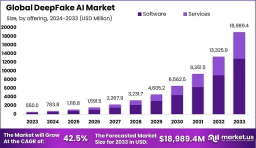

The global DeepFake AI market was valued at USD 550 million in 2023 and is projected to surge to USD 18,989.4 million by 2033, growing at an impressive CAGR of 42.5%. This rapid expansion is driven by rising demand for hyper-realistic video content in entertainment, digital marketing, and security testing. The market’s steep growth curve reflects the expanding use of AI-generated media, creating both opportunities and ethical dilemmas. North America led the market in 2023, generating USD 211.7 million (38.5% share), signifying strong regional adoption and early technological investments by local stakeholders.
Market size to grow from USD 550M (2023) to USD 18.99B (2033).
CAGR of 42.5% forecasted for 2024–2033.
North America holds a 38.5% market share with USD 211.7M in 2023.
Increasing demand across digital marketing, content creation, and cybersecurity.
Ethical use concerns driving regulatory interest globally.
North America held the dominant market position in 2023, accounting for 38.5% of total global revenue, valued at USD 211.7 million. This leadership is attributed to advanced AI research hubs, large-scale media enterprises, and strong investments in AI ethics and regulatory compliance. Governmental funding, startup proliferation, and strategic partnerships with tech firms have empowered the U.S. and Canada to stay at the forefront. Moreover, regulatory scrutiny has been more structured in this region, enabling safer deployment of DeepFake technologies across legitimate use cases while tackling the risk of misuse.
DeepFake AI relies heavily on advancements in Generative Adversarial Networks (GANs), multimodal learning, and neural rendering. These technologies allow the creation of hyper-realistic synthetic media that mimic voice, facial expressions, and gestures with high fidelity. Recent trends include real-time DeepFake creation, low-resource training models, and integration with edge AI to ensure efficient deployment. Deep learning models continue to evolve with greater training data, increasing both the quality and realism of generated content. Tools for DeepFake detection are also gaining momentum to counterbalance malicious applications.
The DeepFake AI landscape is characterized by rapid innovation, regulatory debate, and ethical scrutiny. As technology evolves, global markets must balance commercial adoption with societal implications, fostering a dual ecosystem of opportunity and caution.
Drivers: Demand for personalized content and virtual influencers.
Restraints: Rising regulatory pressure and ethical concerns.
Opportunities: Expansion in cybersecurity and fraud detection.
Challenges: Misuse in misinformation and political manipulation.
Digital avatars in media and gaming
Personalized marketing content
AI-driven voiceovers for content localization
DeepFake detection tools for cybersecurity
Realistic training simulations in defense and healthcare
Virtual spokespersons for branding
The competitive landscape features tech innovators, research-centric firms, and cloud AI providers. Players are leveraging proprietary GAN architectures and synthetic media tools to differentiate. Strategic collaborations, research grants, and patent filings are frequent. Many firms prioritize compliance and integrate watermarking and detection to build trust. Startups are exploring niche domains like voice cloning and deep learning-powered visual dubbing. Large enterprises are focusing on scalable platforms, offering APIs and SDKs for developers to integrate DeepFake generation or detection capabilities across industries.
Advancements in real-time DeepFake generation tools
Integration of DeepFake detection in social media platforms
Regulatory frameworks drafted in EU and U.S.
Launch of AI ethics consortia for synthetic media governance
DeepFake detection challenges organized by major research institutions
The DeepFake AI market is witnessing exponential growth, driven by multimedia innovation and cross-industry applications. While the technology offers vast commercial promise, it demands cautious navigation due to its misuse potential. Stakeholders must innovate responsibly, balancing growth with governance to ensure long-term sustainability and public trust.
| No comments yet. Be the first. |